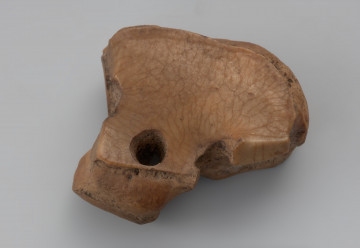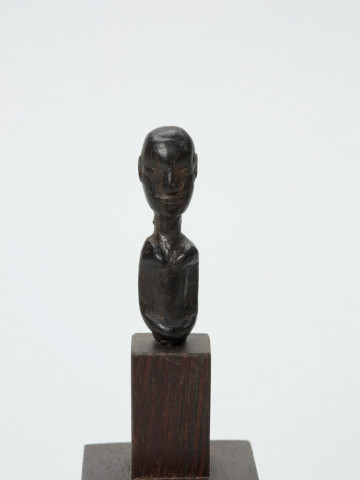
Barrel rattle
1176 — 1200
National Museum in Szczecin
Part of the collection: Middle Ages
A bell-shaped pendant, discovered on Wzgórze Wisielców (Hangman’s Hill) in Wolin during excavations within an inhumation cemetery used in the 9th-11th centuries. Bell-shaped pendants, commonly referred to as bells, have not yet been clearly defined. They are commonly considered to be pieces of jewellery, parts of musical instruments, or associated with the faith in objects being able to ward off evil powers. The sound made by the bell may have been a kind of signal, which informed about a sick person, or an individual who stood out in some other way, approaching. Originally, they could have been attached to bands, just like temple rings, as well as hoods and other headwear, which is evidenced by the fact that they are found near the heads of the deceased buried in the Wolin cemetery. Bells could also have been parts of necklaces or independent elements sewn on clothing, which is supported by the pieces found near the chests. The bell pendant from Wolin is made of thin piece of bronze. Its shape resembles a drop flattened at the bottom, with an eyelet for attaching a string or a wire. The lower, flat part, decorated with subtle grooves, is cut crosswise. In the bell, there is a small bronze ball, which makes the characteristic delicate sound while striking the walls. The oldest bell-shaped pendants, characterised by a slightly different shape than the Wolin ones, have been known since the 8th century and discovered in the Transcarpathian region, while the latest finds date back to the beginning of the 14th century. Since the 10th century bells similar to the one from Wolin were widespread in the Baltic and Ruthenian regions – they arrived in Poland as imports or were local imitations.
Ewa Górkiewicz-Bucka
Author / creator
Dimensions
cały obiekt: height: 2.5 cm, width: 1.9 cm
Object type
musical instrument, pendicle, pendant, adornment
Technique
printing, forging
Origin / acquisition method
acquisition
Creation time / dating
Creation / finding place
Owner
Muzeum Narodowe w Szczecinie
Identification number
Location / status

1176 — 1200
National Museum in Szczecin

601 — 1200
National Museum in Szczecin

między 1951 — 2000
National Museum in Szczecin
DISCOVER this TOPIC
National Museum in Szczecin
DISCOVER this PATH
Educational path